The 15-minute guide to growth marketing

.png)

.png)
It feels like it was just yesterday that growth marketing was having a moment. Oh, wait. It was yesterday—if you count yesterday as the past 10 years. Though it’s been a hot topic for about a decade now, the conversation around growth marketing still creates tons of buzz. Startups are hiring growth teams and implementing growth strategies with increased frequency.
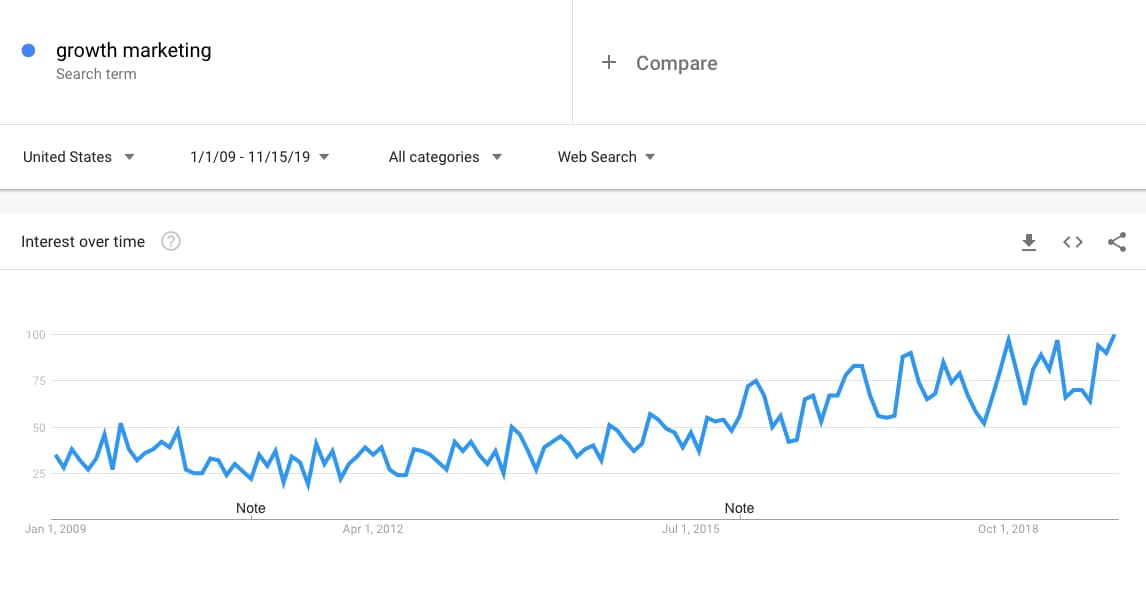
This up-and-to-the-right trajectory is especially important in today’s entrepreneurial climate. Competition is high, and more players in the game make growth marketing increasingly essential. In a crowded space of close to 31 million small businesses in the U.S. alone, you have to stand out to survive. You’ve got to step into the spotlight. That’s where growth marketing comes in.
Growth marketing is a long-term strategy that uses innovative, data-driven techniques to nurture the brand-customer relationship at every funnel stage. With growth marketing, you’re looking to bring in loads of new customers and give them reasons to stay loyal to your brand through engagement.
The ultimate goal is to retain those new users, turn them into brand advocates, and get them to sing your company’s praises. That brand evangelism brings even more new folks to your brand, and hopefully, the cycle continues.
Traditional marketers, on the other hand, often focus on the top of the funnel, creating campaigns to build awareness and acquire as many new leads as possible. Downstream impact—like activation and retention—can fall by the wayside.
Here’s an insider’s take from the head of growth at Census, Sylvain Giuliani:
For me, growth marketing is just the next evolution of marketing, especially for SaaS Companies. Marketing used to be all about copywriting and ads (think Mad Men). Then came the transition to digital marketing (ads on the web and television). Now, marketing has evolved to growth marketing in order to suit the needs of SaaS businesses. Your goal is still to create market awareness and demand, but with a scientific approach and using growth-related metrics.
If you’ve read dozens of growth marketer job descriptions and still don’t know exactly what growth marketers do, no worries. We feel you.
Simply put, growth marketers are data nerds. They use a data-driven approach to increase not only acquisition but also engagement, retention, and brand advocacy. They identify areas for improvement, develop experiments to test their hypotheses, and analyze results—all in the hopes of growing the business.
The term “growth hacking” can be polarizing. While some marketers embrace the title of growth hacker, more traditional marketers feel like the term suggests taking shortcuts to gain more users.
We’re going to settle this debate for you right now. Growth marketing is growth hacking. Growth marketing just has a few more years of experience under its belt.
Coined back in 2010 by GrowthHackers Founder and CEO Sean Ellis, the term growth hacking is synonymous with the tech startup world. Startups are precisely the kind of businesses looking to grow really big and very fast (you know, the whole “move fast and break things” idea).
The growth hacker’s goal is clear: come up with an innovative, novel technique (aka a hack) to quickly achieve incredible growth without a massive budget. The primary focus is on a single metric (often user acquisition), and the avenue to success is usually focused on a specific channel (search, paid ads, email, etc.). We’re talking top-of-funnel stuff here.
Growth marketing is all about playing the long game. When you’re in it for the long haul, you see marketing efforts through the entire customer journey—from awareness all the way through to nurturing. This means you and all of your customers are going to become BFFs!
Long story short, growth hacking is a piece of the growth marketing puzzle. And now that we’ve settled that, let’s discuss how you can get into growth marketing for your business.
If you want a jumpstart in bringing growth strategies to your team or you want to include “growth marketer” in your LinkedIn headline, here’s everything you need to know:
Growth frameworks give you and your team structure—they help you set goals, prioritize experiments, and apply learnings in a way that makes sense for your business.
The Product-Led Growth Flywheel, for example, is a framework for growing your business that focuses on a product-first user experience. The goal is to generate higher user satisfaction and increased advocacy, which in turn drives growth.

The Product-Led Growth Flywheel outlines five sequential user segments that correlate with stages in the user journey, from awareness to evangelism—Stranger, Explorer, Beginner, Regular, and Champion. This framework also outlines the key actions that your product team encourages users to take to graduate to the next stage: Evaluate, Activate, Adopt, Expand, and Advocate.
As more and more users complete each action, the flywheel spins faster, increasing the rate that users move from one segment to the next. This creates a positive feedback loop: more users become advocates, they drive more acquisition, and the rate of growth increases exponentially.
Another growth framework is high tempo testing (also called high velocity testing), which requires a team to launch new experiments at a high frequency in order to shake out insights and create a repeatable process.
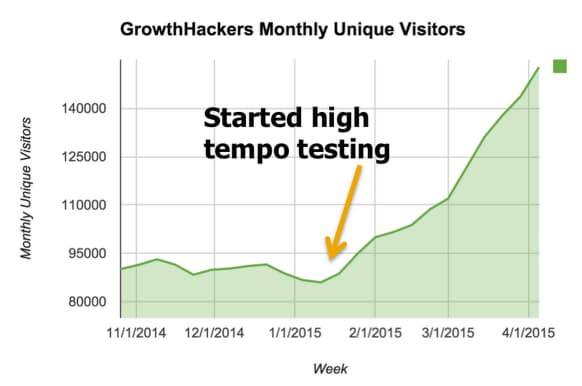
High tempo testing is successful when you focus on three key metrics. You should have a metric for the top of the funnel (like “new site visitors”), one for the middle (like “sales appointments closed”), and one for the bottom (like “content created”).
The process for running high tempo tests can go something like this:
It’s a continuous process formally established by monthly or quarterly meetings—whichever way helps you meet the goal of exponential growth.
Remember growth hacking pioneer Sean Ellis? His framework for scaling a business is called the Startup Pyramid. This process’s foundation is all about the product/market fit.
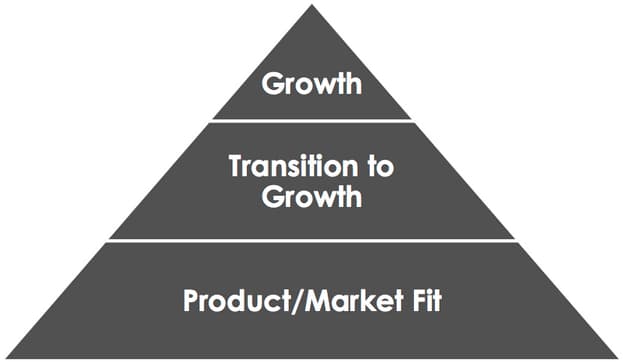
You can’t grow a business with a product no one wants, so you’ve got to assess the product/market fit before even thinking about moving up the pyramid.
Okay, so you know people are going to pick up what you’re putting down. In other words, people want what you’re selling (whew)! Now you can begin the transition to growth. Once you’re at this stage, you need to find your product’s value proposition. When you know what special feature your product brings to the table, it’s easier to get consumers to see it, too.
We’ve finally reached the apex of the pyramid—growth! Let your inner scientist shine; it’s time for experimentation and analysis. You’re ready to market your product. Learn which channels are best for driving growth through continuous testing. Review the data you got from those tests, determine what methods work, and toss the ones that flopped.
If you fancy yourself a growth swashbuckler, you may already be familiar with the next growth framework— Pirate Metrics, or AARRR!
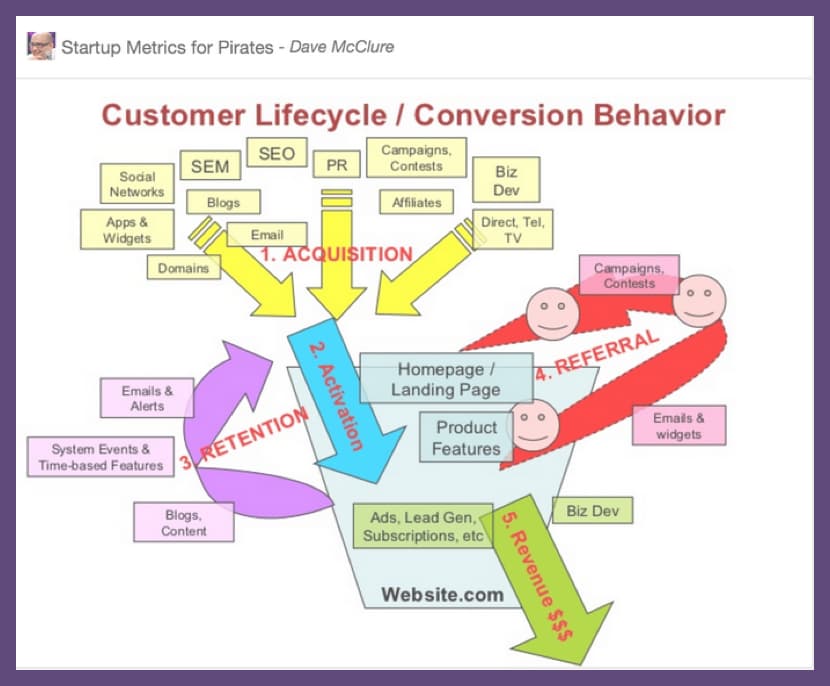
The AARRR! Framework encompasses the whole customer journey and can be broken down as follows:
Calculating your pirate metrics will highlight your growth marketing strengths and weaknesses at the different stages of the funnel.
While growth marketers should always keep the entire flywheel in mind, they tend to focus on conversion milestones that attract prospects and turn them into high-paying customers.
A few key conversion goals include:
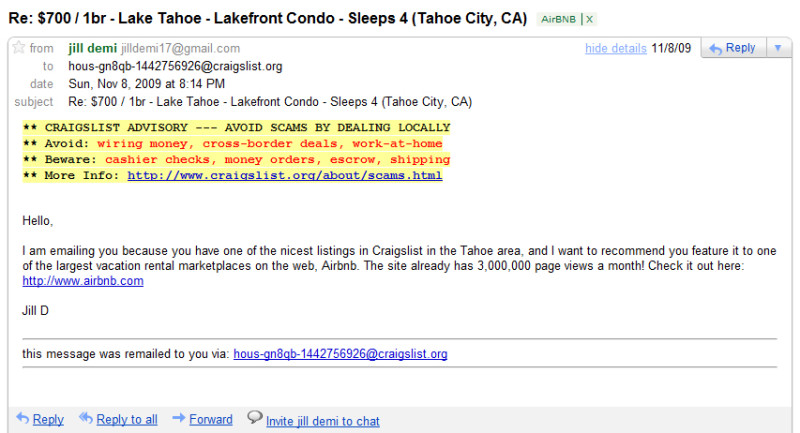
Keep the above conversion goals in mind as you get ready to develop a strategy to scale your business.
Growth marketing is more than just trying out an exciting, never-been-done-before hack to get new users. Successful growth efforts are part of a well-developed plan that starts with an overarching end goal.
Need an assist with strategy creation? We have a framework for that! Approach growth strategy creation with the EMBED Framework.

Start by establishing your end goal. Because you’re focused on more than just acquiring new users, you need to be clear on the results you hope for years down the line. Consider your specific revenue goals or your internal team’s ideal size, one, five, or 10 years into the future. What specific areas of your business do you wish to grow?
Once you have your desired outcome in mind, select the growth framework that will best suit your end goal. We mentioned a few earlier in this article. Think about the current state of your business, and choose the framework that will best help get you to where you want to go.
Next, map out your strategy by identifying your key metrics. Start by finding your North Star Metric—the one metric that represents your value proposition and helps you focus on sustainable long-term growth through customer retention. Your North Star could be monthly active users or the number of deals closed.
Growth marketing team, assemble! Bring in the growth hackers (and the rest of your marketing team)! It’s time for some big ideas. Now’s the moment when you get to brainstorm what tactics you can use to drive growth, engagement, and retention. Throw your wildest ideas out there on how you’ll achieve the goals, objectives, and key results you set. No idea is too grand at this stage.
You’ve worked hard creating your strategy. Get ready to execute it. At this point, take your list of big ideas and filter out the ones that don’t show a clear path back to your end goal. The idea you’re left with here is the one you’ll move into the experimentation stage.
Before you start testing this tactic, you need to come up with a hypothesis to figure out what you expect to happen when you execute your strategy. Once you have a hypothesis, you’re ready to develop and test your minimum viable product (MVP). Run A/B tests with your MVP to gather data about your tactic’s strengths and learn what ideas you should abandon.
You’ve wrapped up the experiments. You’ve got data on hand. Analyze the data, and see if your hypothesis proved true. Determine if this tactic would make a valuable addition to your growth strategy in the future. If it didn’t work, figure out why.
Got all of the info you need? Great! Now get ready to do it again. And by “it,” we mean revisiting the “E” in EMBED. Use these insights to learn how to further optimize your growth strategy as you move forward and repeat the process for your next goal.
Growth marketers wear many hats: copywriter, product manager, and data analyst, to name just a few. We prefer beanies.
With so many diverse tasks on their plate, most growth marketers turn to third-party tools to help drive results faster.

Here are a few of the most important growth marketing tools to have in your toolkit:
If you want to learn more, check out our comprehensive list of growth marketing tools.
One of the best ways to learn is to understand what has and hasn’t worked in the past. But getting insider insights from successful growth marketers isn’t so simple when they won’t accept your request to connect on social media. Luckily, there are a number of growth marketing experts who share successes, failures, and industry knowledge on their personal blogs.
Here are some of the growth marketing blogs we have bookmarked:
Looking for more resources? Check out this article for some of our favorite product marketing resources, from blogs to books to podcasts.
Though popular growth hacks shared by growth hacking influencers and startup founders may seem like shortcuts to success, the truth is that growth marketing is really just good marketing.
Growth marketing includes all the pillars of an effective marketing strategy: setting goals, forming a hypothesis, and gathering and analyzing data. And, of course, thinking about the entire customer journey, from acquisition to retention.
These are things every marketer should care about and be accountable for, whether they include “growth” in their title or not.
To learn more about the rise of growth titles, check out this piece on the rise of the growth product manager or this one on the skills growth PMs need to succeed.